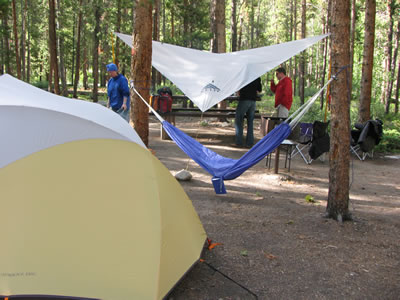| 269 | Noah, a Tarp | 2010-08-18 |

When I first began backpacking and camping on my own, I used a piece of plastic as a tarp. I was only eleven; but could still set the tarp so that I slept mostly dry. At the time I was not smart enough to use a sleeping pad, so I usually got wetter from the ground than the sky; but that's another story.
As I grew older, I finally bought a square cut nylon tarp. It was nothing special, just coated ripstop nylon with a few grommets. The nylon was easier to set up and maintain than the plastic tarp; but I still had to use rocks twisted into the nylon as tie-off points. I did sleep drier.
Still years later, I bought a tent, and left the tarp behind. No more swatting bugs all night. No more waking up in a storm to find a river running under my sleeping bag. No more having to have at least one good tree to set the tarp up.
I never used a tarp again, except when working with outdoor education groups. Tarps were still the cheapest way to afford some protection from the elements.
Then a few years ago we bought a Kelty Noah Tarp (12 x 12) from REI. We were not going to sleep under the tarp, instead we just wanted to use it as an extra shelter when car camping. Noah began to be packed for every camping trip.
With adjustable poles (not included with the tarp) the set up is a snap. Loosely stake out the four guy lines, stick in the two poles, and begin adjusting. The catenary cut makes a taut (flap free) set-up, easy.
Amy, my wife, is a teacher and uses Noah for outdoor school events. Some teachers use the expandable shelters, instead. The Noah is more versatile and secure than the framed shelters and weighs only a fraction as much. I even think the set-up of Noah is easier than the framed shelters. Amy's sixth graders give her more help than she needs to set it up!
A few notes...
- At REI, Noah sells for $70; but that is without poles.
- The good aluminum poles cost more than the tarp! There are alternatives though. Adjustable poles work best, but don't underestimate a good stack of rock to add adjustability.
- The tarp can be set up without poles, but it at times is hard to find two trees spaced properly.
- The 12 foot by 12 foot size seems almost perfect.
- It only weighs 2.5 pounds! but that is without the poles.
- Another advantage of NOah is that it packs small.
- The guy lines on the tarp are (and need to be) long. It is important to devise a system to help manage the cord or unpacking Noah becomes a hassle with a web of tangled cords.
- We have not tried the MSR Zing or the MSR E-Wing Shelter; but we are interested in both.
After using the Noah for a number of years, we would highly recommend it for car camping, outdoor events, and the beach. The few times we have not carried it with us; we wished we had. Noah has given us that extra outside room during many rain storms without giving us a lot of weight or taking up a lot of space. What more can you ask for?
Happy tarping trails.